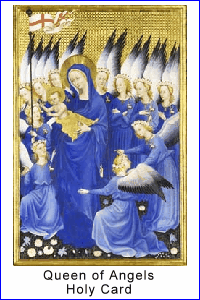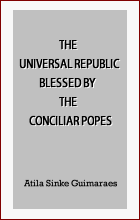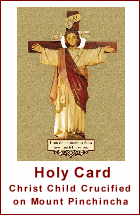What People Are Commenting
Pro & Con Liturgical Reforms &
St. Edward’s Ring
The Ring of St. Edward the Confessor
TIA,
Thank you for the Saint of the Day on St. Edward the Confessor. I thought your readers might like to know why the Saint is often presented holding a ring, as in the picture in your article. The legend is this:
The King's life was drawing to a close just as the great Abbey at Westminster was completed, and Edward knew that this was so. It was said that as the King was on his way to the dedication of a chapel to St. John, he was met by a beggar who asked alms of him. "I pray thee help me, for the love of St. John," cried the beggar.
Now the King could not refuse such a request, for he loved St. John greatly. But he had no money with him and his Steward Hugolin was not at hand, so he drew off from his finger a large ring, royal and beautiful, and gave it with a kindly smile to the poor beggar.
Not very long afterwards, the legend tells us, two English pilgrims far away in Syria lost their way and wandered about in darkness and amidst great dangers, not knowing which road led to safety. They were almost in despair, when suddenly a light shone across their path, and in the light they saw an old man with bowed white head and a face of wonderful beauty.
"Whence do ye come?" asked the old man, 'and what is the name of your country and your King?"
"We are pilgrims from England," replied the wanderers, "and our King is the saintly Edward, whom men call the Confessor." Then the old man smiled joyously, and led them on their way until they came to an inn.
"Know ye who I am?" he asked. "I am St. John, the friend of Edward your King. This ring which he gave for love of me, ye shall bear back to him, and tell him that in six months we shall meet together in Paradise"
So the pilgrims took the ring and carried it safely over land and sea until they reached the King's palace. There they gave it back into the royal hand and delivered the message from St. John. For a few days he lingered on, and then from the land of dreams he passed to the great Reality, and the old chronicles add the comforting words: "St. Peter, his friend, opened the gate of Paradise and St. John, his own dear one, led him before the Divine Majesty."
Thank you for your daily updates and Saints of the Day.
E.F., London
Thank you for the Saint of the Day on St. Edward the Confessor. I thought your readers might like to know why the Saint is often presented holding a ring, as in the picture in your article. The legend is this:
The King's life was drawing to a close just as the great Abbey at Westminster was completed, and Edward knew that this was so. It was said that as the King was on his way to the dedication of a chapel to St. John, he was met by a beggar who asked alms of him. "I pray thee help me, for the love of St. John," cried the beggar.
Now the King could not refuse such a request, for he loved St. John greatly. But he had no money with him and his Steward Hugolin was not at hand, so he drew off from his finger a large ring, royal and beautiful, and gave it with a kindly smile to the poor beggar.
Not very long afterwards, the legend tells us, two English pilgrims far away in Syria lost their way and wandered about in darkness and amidst great dangers, not knowing which road led to safety. They were almost in despair, when suddenly a light shone across their path, and in the light they saw an old man with bowed white head and a face of wonderful beauty.
"Whence do ye come?" asked the old man, 'and what is the name of your country and your King?"
"We are pilgrims from England," replied the wanderers, "and our King is the saintly Edward, whom men call the Confessor." Then the old man smiled joyously, and led them on their way until they came to an inn.
"Know ye who I am?" he asked. "I am St. John, the friend of Edward your King. This ring which he gave for love of me, ye shall bear back to him, and tell him that in six months we shall meet together in Paradise"
So the pilgrims took the ring and carried it safely over land and sea until they reached the King's palace. There they gave it back into the royal hand and delivered the message from St. John. For a few days he lingered on, and then from the land of dreams he passed to the great Reality, and the old chronicles add the comforting words: "St. Peter, his friend, opened the gate of Paradise and St. John, his own dear one, led him before the Divine Majesty."
Thank you for your daily updates and Saints of the Day.
E.F., London

Posted October 8, 2015
______________________
The opinions expressed in this section - What People Are Commenting - do not necessarily express those of TIA
______________________
______________________















I read with interest Dr. Carol Byrne's recent article on Pope Pius XII's Assisi Address. In order to get the proper context, I also read the Address for myself. While praising the good results of the Liturgical Movement, Pius made it clear that the Church was vigilant and on alert regarding theological tendencies associated with the Movement, or some of its members, and he spoke of his duty, as pope, to "forestall whatever might be a source of error or danger."
I realize it wasn't Dr. Byrne's intention, but now I understand why so many Catholics praised Pius XII and his reforms, and I agree with them. He really did foil the liberals, and the Church flourished and was magnificent throughout his entire pontificate.
Sincerely,
T.C.
Dr. Byrne responds:
Dear Madame,
Thank you for your interest in reading my latest article on the Liturgical Movement under Pope Pius XII and for offering your opinions. It would have been of greater benefit, however, if you had provided some solid evidence for the points you make.
For example, the “good results of the Liturgical Movement” is a value judgment, not a fact, and one with which many traditionally-minded Bishops and priests in Pius XII’s time vehemently disagreed. Records exist to show that they considered these reforms unnecessary, imprudent and in some cases a destabilizing factor in the life of the Church. Please spare a thought for those Bishops who were forced by Pius XII to act against their principles.
You also state, without any evidence, that Pius XII “really did foil the liberals.” Surely you have it precisely the wrong way round.
In my previous articles of the series I have, with the help of supporting documentation, shown that throughout his entire reign Pius XII adopted an increasingly conciliatory approach to the demands of liturgical reformers. What is more, he created a Commission of liturgical “experts” with a progressivist agenda and entrusted key offices to them, carrying great power and influence, allowing them to become the dominant force in the Liturgical Movement.
To those liturgists present at the Assisi Congress who were change agents of the Liturgical Movement, he said in his Address that it was “a consolation and a joy for Us to know that We can rely on your help and your understanding in these matters.” As these were the very same liturgists who would go on to demolish the Church’s liturgical traditions at Vatican II, we could say that Pius XII was the Pope who put the match to the powder train which would explode a few miles down the line.
Your claim that Pius XII acted to “forestall whatever might be a source of danger or error” rings hollow. Moreover, being “vigilant and on the alert” against “theological tendencies” while the progressives were gaining the upper hand is no substitute for taking effective action against dissident reformers. While Pius XII gave the true Catholic teaching on the priesthood, in the practical area his reforms were based on those same “theological tendencies” in the Liturgical Movement which challenged Catholic doctrine on the priesthood, the Holy Mass and the Sacraments.
And that is the difficulty, dear Madame. It was Pius XII’s profound ambivalence that made effective papal control of the Liturgical Movement impossible. Whose side was he really on – the progressives’ or the conservatives’? Opposing factions continue to claim victory, as your letter only too clearly shows.
On one point I agree with you: the Church under Pius XII was flourishing and magnificent, but the point of my latest article is that it was being fatally undermined in his pontificate by what I called fault lines and tectonic shifts. As you do not seem to have taken the point, let me propose another metaphor, that of the progress of a tsunami.
Somewhere, under the ocean, an earthquake occurs and launches a wave. The wave is not very high, only about 1 meter, so if you were at sea you would not notice any difference. But as the wave is hundreds of miles wide and also travels at hundreds of miles per hour, it carries a phenomenal amount of pent-up energy in complete quiet and repose. Still, it seems quite innocuous to the unwary. Only when the wave reaches the coastline does it rise up in a great wall of crashing water. Only then is its full destructive potential released.
We Catholics who lived through the pontificate of Pius XII could not have known that a tsunami was heading for the shores of the Church. Now, with hindsight, we can see the cresting wave of Vatican II and that it was far higher than anything most people expected.
Yours sincerely,
Dr. Carol Byrne